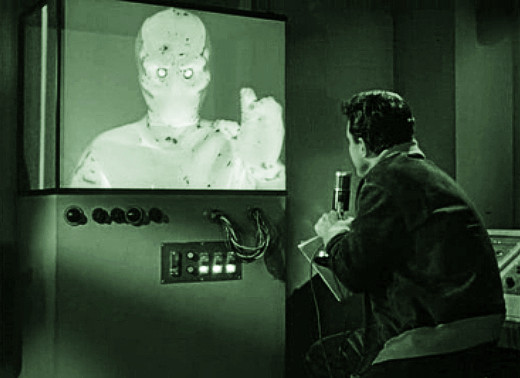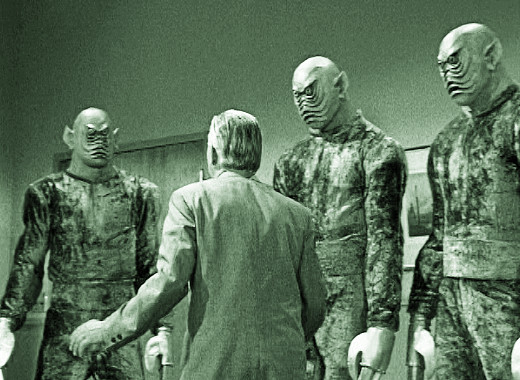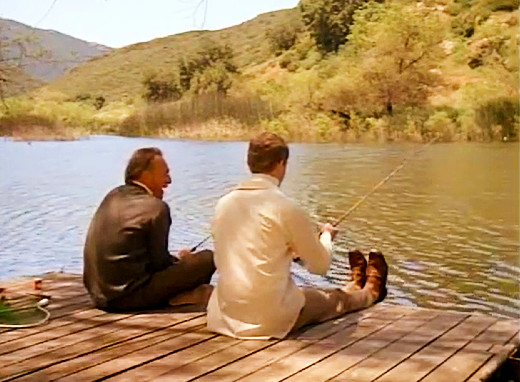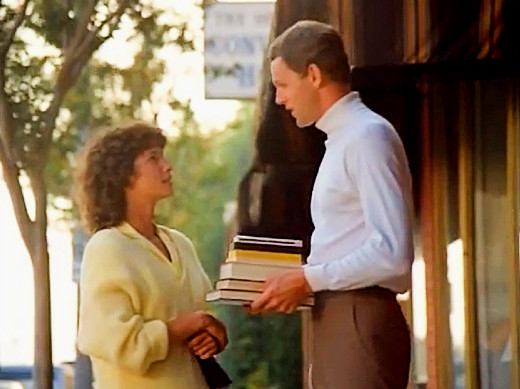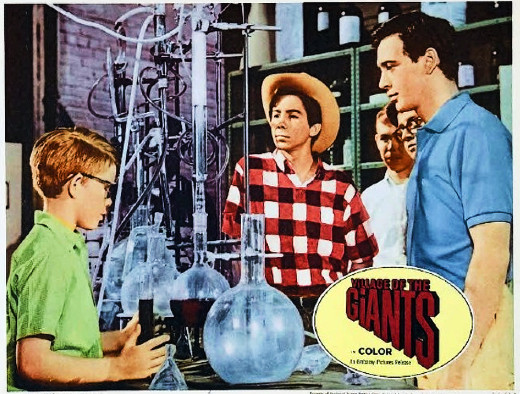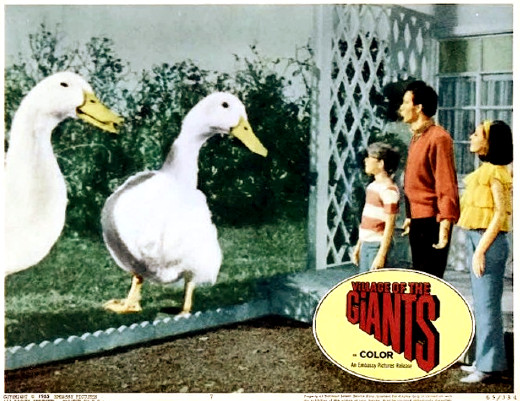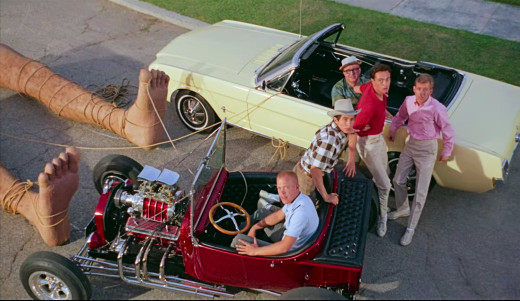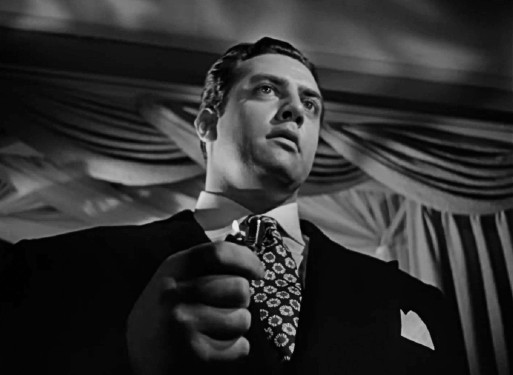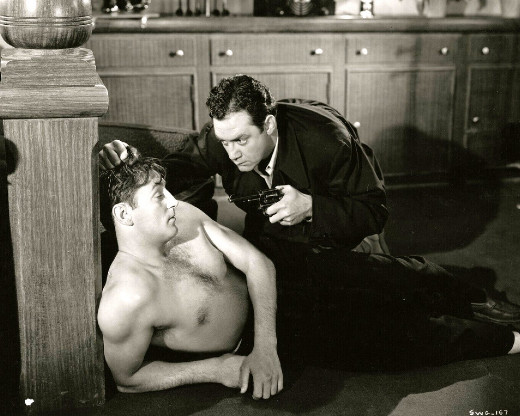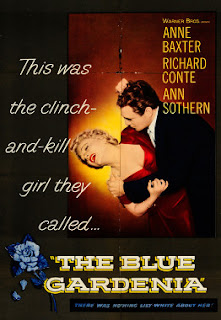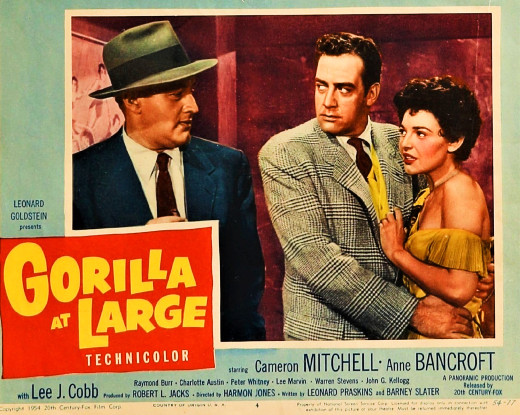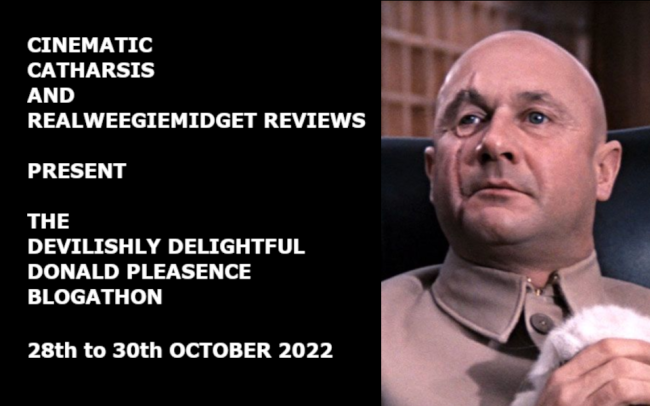Now Playing: Alone in the Dark (1982)
Pros: Great cast led by Donald Pleasence, Jack Palance and Martin Landau; Good building of tension; Lots of sly black humor
Cons: Casting two familiar actors in the maniac roles somewhat undermines the characters’ menace
Even though the end of October is my busiest time during my favorite season, when I saw that fellow bloggers Gill from Realweegiemidget Reviews and Barry from Cinematic Catharsis were hosting a Donald Pleasence blogathon, I couldn’t turn down the opportunity.
I first encountered Mr. Pleasence when my parents took me to see The Great Escape at the fancy cinema in the big city. In this great WWII epic set in a German prisoner of war camp, Pleasence plays Blythe, an unassuming little man that no one would look twice at -- except that he is a master forger, and the men planning their escape from the camp need his help creating ID papers. Ironically, he was very prepared for the role. During the war Pleasence was a crew member on an RAF bomber that was shot down over France, and he spent time in just such a camp.
For my next encounter, I stood in a long line at the local downtown theater to see You Only Live Twice (naturally, this was before the era of multiplexes). Pleasence’s turn as the Bond super villain Blofeld is memorable. Blofeld, his face hidden behind a screen, strokes his beautiful Persian cat as he orders his minions around in a quest for world domination. Later on, the reveal of his scarred face is worthy of a horror film, and You Only Live Twice immediately became my new favorite movie (not that I needed any excuse to like James Bond movies at that age).
Somehow, this diminutive, soft-spoken, professorial-looking man could play the most endearing, gentle person in one film and then make your blood run cold the next. Speaking of blood running cold, while Pleasence was by no means a horror specialist, he made his fair share of horror films, enough for at least a couple of Halloween film festivals.
 |
Blofeld suddenly realized that in his haste
to blackmail world leaders, he forgot
to pick up more kitty litter. |
One of his earliest and best horror roles was as the slimy Mr. Hare in The Flesh and the Fiends (1960), the creepiest retelling of the infamous Burke and Hare story that you’ve never heard of (see my review here). In the early ‘60s, guest shots on such spooky TV series as One Step Beyond, The Twilight Zone and The Outer Limits indicated his potential for creepy roles.
By the early ‘70s, the horror roles became more numerous. Pleasence played an inspector in the claustrophobic cult horror Death Line (aka Raw Meat, 1972), then a mad doctor in The Freakmakers (aka The Mutations, 1974). Along the way were memorable appearances in the anthology fright fests Tales that Witness Madness (1973) and From Beyond the Grave (1974). Whether he was playing good guys or villains, he always lent an aura of class to these low-budget films.
Pleasence is perhaps best remembered for his role as Dr. Loomis, Michael Myer’s attending psychiatrist and grim adversary in the Halloween film franchise. Although horror movies traditionally have portrayed psychiatrists as hopelessly naïve and easily duped by the depraved psychopaths they’re treating, Loomis is famously clear-eyed and adamant in the original Halloween: “I spent eight years trying to reach him, and then another seven trying to keep him locked up, because I realized that what was living behind that boy's eyes was purely and simply... evil.”
A few years after uttering that severe judgment, Pleasence would play yet another psychiatrist in a horror film, only this time his character, Dr. Leo Bain, would be the complete opposite of Loomis -- idealistic and naïve to a deadly fault.
Like many slasher films, Alone in the Dark (1982) operates in a Dirty Harry kind of world where do-gooders who believe criminals can be reformed and lunatics can be cured (or at least controlled) are setting themselves up to be lambs to the slaughter.
The slaughterers in this case are a quartet of psychos who occupy the third floor of an institution run by Dr. Bain. Bain doesn’t like the loaded term “asylum,” preferring to call his institution “The Haven.”
 |
| The New Age psychiatrist in his natural habitat. |
Bain’s Haven is home to all kinds of crazies, er, um ill people, but the boys on the third floor are psychopaths with a history of murder and mayhem. “Fatty” Elster (Erland van Lidth) is an obese child molester. John “The Bleeder” Skaggs (Phillip Clark), who doesn’t like to show his face, is a strangler who gets severe nosebleeds when he kills. Byron “Preacher” Sutcliff (Martin Landau) is a former minister who believes he’s on a mission from God, and has a tendency to burn down churches with people inside them. The leader of the group, Hawkes (Jack Palance), is a grizzled war veteran with a severe case of homicidal post-traumatic stress disorder.
As Bain is giving a tour to his newest staff doctor, Dan Potter (Dwight Schultz), he explains that the state authorities were at first nervous about Bain keeping these dangerous inmates, but let it go when he installed electric sensor-operated steel shutters that allow the men to roam the floor, but are activated if they try to leave their confines. Later, the third floor orderly Ray Curtis (Brent Jennings) confides to Potter that all that separates him (and the outside world) from these men is electricity. He also warns the new doctor that Hawkes is convinced that Potter killed his predecessor, Dr. Merton, who left The Haven to take another position.
Potter brushes off Curtis’ warning about Hawkes, chalking it up to a typical inmate’s delusion. But, unlike the smugly confident Dr. Potter, we know just where this is heading -- the power is going to go off, the third floor inmates will escape, and there will be hell to pay.
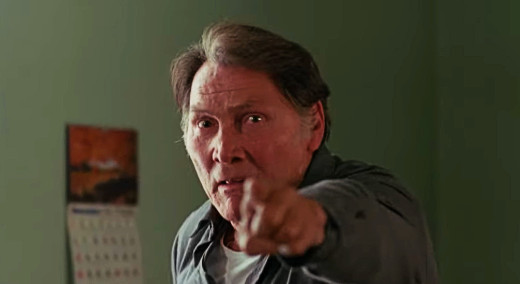 |
| "DR. POTTER!! ... Happy...trails..." |
Coming out in 1982, Alone in the Dark rode the wave of slasher films that followed in the wake of the surprise hits Halloween (1978) and Friday the 13th (1980). Slashers seemed like a natural fit for a Zeitgeist molded by Vietnam, Watergate, oil shortages, stagflation and rising crime, where trust in authorities and a society that could keep us safe and secure was at an all-time low. Slasher films taught us that no place was safe, not small towns, big cities, summer camps, sorority houses… zip, zero, zilch. Even Reagan’s “Morning in America” couldn’t tamp down these exceedingly dark films.
Alone in the Dark is a classic artifact of its time, and a relentless indictment of it: authorities are incompetent and clueless, and society is just one power blackout away from savage chaos.
Exhibit #1 in the list of indictments is Dr. Bain. Bain is the ultimate touchy-feely, new-agey intellectual who doesn’t seem to be living on the same planet as the rest of humanity. He tells Potter that the Haven’s inmates aren’t patients, but rather “voyagers taking a journey into the innermost reaches of the psyche.”
Bain values the voyagers’ welfare to the point that he is oblivious to the dangers they pose to the outside world. He indulges the firebug “Preacher” by giving him matches, which the man promptly uses to light his coat on fire and swing it wildly around.
Later, after Hawkes & crew have made their escape and are racking up a body count, Bain frets that the men are “still disturbed by their escape,” and their violence is “a cry of pain.” In another bit of black humor, Bain tries to phone Potter’s home, but the line has been cut. He argues with the operator, who can’t convince him the line is out. When she ends the call with a sarcastic remark, Bain mutters to himself “Now she’s got a serious problem!” In playing the part absolutely straight, Pleasence manages to elicit a bit of sympathy for a character that is otherwise dangerously out-of-touch.
More deserving of sympathy is Dr. Potter, whose decision to take a new job at the Haven turns out to be the worst of his life. Moving your family to a new place is hard enough without the homicidal inmates at your new workplace deciding that you’ve killed their beloved doctor, and then being set free by a freak power blackout to stalk you and your loved ones.
 |
| Bain and Potter discuss the wisdom of giving matches to pyromaniacs. |
Even before that particular sh*t hits the fan, Potter is stressed after his tour of the facilities and observance of Dr. Bain’s decidedly unique methods for handling the residents. His wife Nell (Deborah Hedwall) is skeptical, flippantly asking “Why can’t you just get an office and treat neurotics like a normal person?”
To add insult to injury, Potter's neurotic, needy sister Toni (Lee Taylor-Allen) is visiting for the week, and, dressed in a punk outfit and pink hair, she insists on dragging her brother and sister-in-law to a punk rock concert headlined by The Sick F*cks (a real band, it turns out). The only member of the family who seems unaffected by all the turmoil is the Potter’s young daughter Lyla (Elizabeth Ward), who calls her parents by their first names and has the grating self-confidence of a precocious pre-teen.
It’s while the group is at the concert that the power goes out. Potter is grateful for the reprieve from the musical stylings of the Sick F*cks, but little does he know that the outage has set in motion a chain of events that will end up with he and his family holed up in their house, trying to dodge crossbow arrows and hunting knife blades wielded by another band of truly sick f*cks.
Living in our current age of anxiety, it’s easy to forget that there have been other periods when popular opinion held that we were well and truly screwed. In addition to Dr. Bain’s questionable authority -- it’s tempting to think that he’s not a real doctor, but one of the inmates running the asylum -- Alone in the Dark depicts a world that is ready to crumble into chaos at a moment’s notice.
The blackout turns the quiet little town into a seething mass of rioters and looters. When Hawkes and his band arrive in town in their stolen car, they’re completely in their element. Hawkes looks around at the cars on fire and the broken store windows and beams with satisfaction, like a victorious general surveying the battlefield. As the inmates join a crowd of looters at the sporting goods store and help themselves to all kinds of knives and weapons, they’re barely noticed in all the confusion.
 |
| The boys help themselves to sale items at the local sporting goods store. |
It’s probably no coincidence that the two most colorful Haven escapees are an ex-military man and an ex-preacher. Along with Bain representing medical science, Hawkes and Sutcliff are highly dubious representatives of their respective institutions. Alone in the Dark suggests that not only are the inmates running the asylum, they’re threatening to run the whole world.
But Bain, Hawkes and Sutcliff aren’t the film’s only digs at contemporary society. At one point, as the Potters are trying to deal with the consequences of the blackout, an announcer on the radio playing in the background reads a press release from the local nuclear power station denying any responsibility for the power outage (corporate speak for “we’re as guilty as hell, but just try to prove it!”). That's Toni's cue to be “helpful” once again and drag sister-in-law Nell to a huge protest at the plant.
She only manages to get Nell and herself jailed for disturbing the peace. And through parental miscommunication, Lyla is home alone. Uh-oh!
Alone in the Dark does a masterful job of ratcheting up the tension, slowly at first, with the “something’s not quite right here” tour of The Haven, to the maniacs casing the Potter’s home (the Preacher pretends to be a telegram messenger, and Fatty poses as Lyla’s babysitter), to the all-out assault on the family at the climax.
 |
| The boys enjoy a ride around town. |
Along the way, in addition to the sly commentary, it also has fun with slasher tropes (or should I say, plot elements that were soon to become tropes in the ‘80s). There’s the classic clueless babysitter who, after making sure the kid is asleep, invites her boyfriend over to fool around. The writers set up a clever bit of misdirection when she hears strange sounds, and insists that the boyfriend check out the bedroom closet.
The stellar, high-profile cast, especially Jack Palance and Martin Landau, is the film’s biggest asset and at the same time its biggest weakness. Palance, no matter the role, always looked like he was ready to explode at any moment, and is a perfect fit for the hand-grenade-without-a-pin that is Hawkes. And when Landau breaks into his wide-eyed, evil-Joker smile, he sends chills up the spine.
But the atmosphere of dread that Alone in the Dark takes pains to cultivate is undercut by making the characters a little too familiar, what with their background stories and recognizable faces. By contrast, the unseen killer in the original Friday the 13th is a complete surprise at the end, and Halloween’s Michael Myers is an evil enigma, a “shape” behind a rubber mask.
This was not the only horror film Palance and Landau would make together. A couple of years earlier, the two appeared in Without Warning (1980), a low-budget sci-fi/horror film featuring a Predator-like alien hunting humans in the woods.
 |
| "Heeeerrrrrrrrrrre's Byron!" |
Both would go on to score dark horse supporting actor Oscar wins, Palance for City Slickers (1991) and Martin Landau for Ed Wood (1994). And of course, Donald Pleasence would become a fixture as Loomis in one of the most successful horror film franchises of all time.
Alone in the Dark was writer-director Jack Sholder’s first feature, and it’s quite a debut. In the next few years he made two more minor cult favorites, A Nightmare on Elm Street 2: Freddy’s Revenge (1985) and The Hidden (1987), then settled into directing TV movies and episodes.
When I found out about the blogathon and was perusing Donald Pleasence’s IMDb resume for a good Halloween choice (excluding the Halloween movies, which others have written about extensively), Alone in the Dark jumped out at me because I had no recollection of ever seeing it or even reading about it. I’m not a big fan of slasher movies, but I’m at least aware of the classics and some of the also-rans in the genre, so stumbling across an unknown (to me) horror film starring not only Donald, but Jack and Martin as well was a Pleasence surprise (sorry, I couldn't help myself).
Usually in these cases, the reason I’ve never heard of a film is because it’s so bad even bad movie lovers have steered clear over the years. Since Alone in the Dark is very good, it remains a mystery how it evaded my attention all this time. Thanks to Gill and Barry and their Devilishly Delightful Donald Pleasence blogathon for indirectly steering me to this great find!
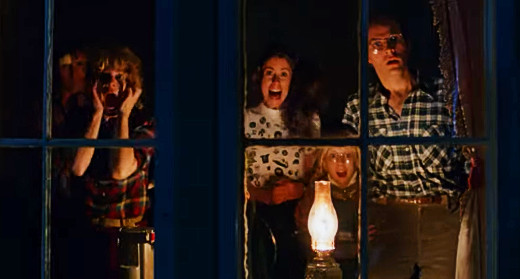 |
Alone in the Dark is a good reminder that it pays to be prepared for emergencies
like power blackouts and/or homicidal maniacs invading your home. |
Where to find it: DVD/Blu-ray | Streaming
